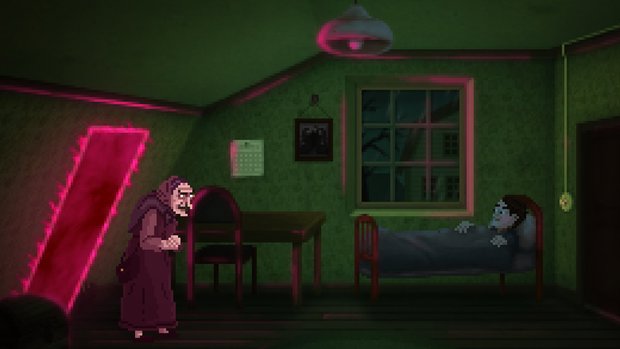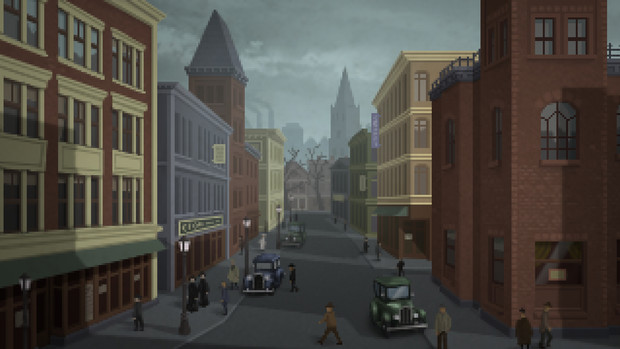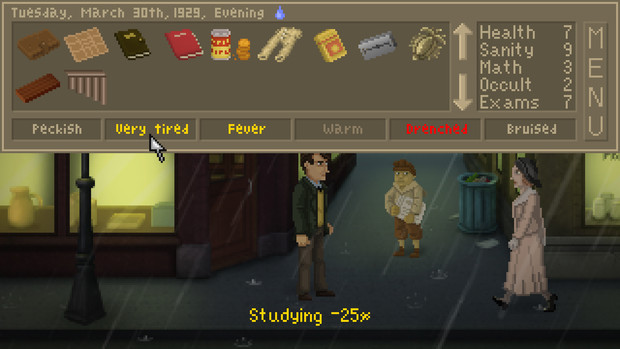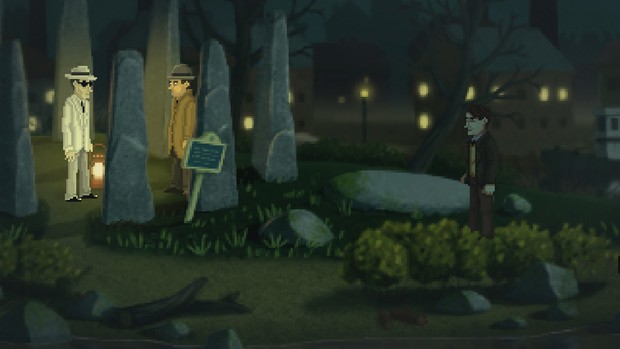Dreams in the Witch House review

- 2 Comments
Spellbinding concoction of RPG, resource management and retro adventure ingredients
If you ever wondered what an open-world, point-and-click pixel art horror adventure filled with resource management and roleplaying would look like, then Dreams in the Witch House is your answer. Its challenging character maintenance might drive you as mad as the main character, leaving you constantly wondering if the decisions you make and paths you take are the right ones, but being a game based on the writings of H.P. Lovecraft, in a story where danger lurks around every corner, that’s exactly where the fun lies. There’s a multitude of ways to approach the game, whether you actively delve deep into the paranormal storyline, or choose to ignore everything of an occult nature and try to play it safe, simply aiming to survive on limited resources. The city of Arkham, Massachusetts is your playground, and the ability to shape the life of the main character as you see fit is what will keep you thoroughly entertained all the way to one of multiple possible endings – assuming you don’t die or go insane along the way.
As Walter Gilman, a math student working on a research project trying to connect science to the occult, you're able to find lodging in Arkham to attend the Miskatonic University in the year 1929. This is no ordinary city, however, so not only will you have to spend time studying, you must also maintain your health and sanity in RPG fashion, all while slowly uncovering the dark secrets lurking beneath the city (or not). The days will fly by and you have to choose your path carefully yet quickly if you want to make sure Walter survives this adventure of a lifetime.
Legend has it that 300 years ago Keziah Mason escaped the Salem witch trials, and ever since she has haunted the city where she once lived. Even now, people often catch glimpses of Keziah and her familiar, a huge rat named Brown Jenkin. Over the years the city has also had its share of disappearances, which are always but never officially attributed to the witch. All of this strange activity in Arkham centers on Walpurgis Night, or May-Eve, the night before the first of May. It’s the European feast day to ward off evil spirits and witches (very similar to Saint John’s Eve of Gabriel Knight: Sins of the Fathers fame). The game starts on March 1st with Walter’s arrival, and he’ll have two months of weirdness ahead of him, which should be enough time to prepare himself for the final showdown.
At first Dreams in the Witch House appears to be a typical old-school pixel art adventure with no voice-over. Text speed is adjustable, and you can wait until the dialogue changes automatically, or you can click it away. A right mouse click examines labeled hotspots; a left click interacts with them. The backgrounds depict a classical early twentieth-century New England town with its distinctive colonial architecture, and the characters are garbed in era-appropriate clothes. The world is filled with loads of non-interactive extras like fellow students poring over books in the library, or townspeople passing by in the streets, turning Arkham into a lively, dynamic, if retro-looking town.

More impressive than the artwork is the quality of the soundtrack, which astounded me from the moment I launched the game. It reminded me of Alan Silvestri perhaps – very dramatic music, with lots of violins and brass, as you’ve probably heard in numerous 90s adventure movies with a spooky edge. The orchestral score is actually composed by Troy Sterling Nies, known for his work on The Call of Cthulhu, and it is sooo good. Besides the music there are tons of environmental sound effects as well. Every location comes alive and you constantly hear things you can’t even see, like footsteps, doors opening and closing, creaks and scratches. Remember the old adage: a good horror story scares you with what you DON’T see.
Before long it becomes apparent that there’s something quite atypical about this game, namely its heavy RPG element. When you start, you are offered the choice of three difficulty levels: easy, normal and hard. The difference lies in the survival mechanics you have to employ in-game. My initial playthrough was on easy mode, since I’m no roleplaying aficionado, and after only four hours of living Walter’s life, I was already convinced I’d never survive normal mode. I saved so often that I felt like I was back playing one of the old trial-and-error-heavy Sierra classics. Indeed, more than once I imagined myself back in the medieval town of Spielburg, but more on a quest for sanity than a quest for glory.
After finishing my playthrough on easy, however, I did try out normal mode. Since I already knew what was going to happen in the story, I thought I would have an advantage so I didn’t save as often. Turns out it was a totally different gaming experience. This time I concentrated on Walter’s studies, but I had less money to keep him fed, and he got sick a lot faster than in easy mode, so a big part of my available budget went to cold medicine, and when things really got hairy, to pain relievers. On hard mode you get even less money to spend. There’s also an Ironman Mode, which disables the manual save system and forces you to rely on the autosave function.
The game’s menu provides you with a complete “Witchopedia,” which is basically the manual, explaining all the RPG elements. I recommend reading through it for a better grasp of every aspect of the gameplay you will encounter. Don’t worry, it’s not THAT extensive, so it’ll only take a couple of minutes.

Walter is a normal person and you’ll have to take care of him as such, almost like a human Tamagochi. He needs food, sleep, and most importantly if you want to reach any kind of good ending, he needs to preserve his sanity because lots will happen to slowly make him go completely mad if you allow it. All kinds of mishaps can assault his mental wellbeing: seeing a rat in his room, getting robbed, not sleeping enough or having strange dreams, etc. Structure helps preserve that sanity, and working your way through his to-do list (accessed through the inventory or by pressing the appropriate hotkey) is perfect for that. The list also helps to keep track of your immediate goals. All of Walter’s character stats and conditions are displayed near the inventory, visible when moving the cursor to the top of the screen.
When you leave your current area, you can select your next destination from an overview map. Possible locations are the university, the city center with a convenience store and a pharmacist, and a coffee house/restaurant, along with other places you unlock as the story progresses. Walter gets hungry, so you’ll have to find him food at regular intervals. But he gets tired traipsing all over the city, so he’ll need to sleep as well. Unfortunately his sleep can be interrupted by strange noises, weird dreams or even Walter’s own maddening thoughts. Buying sleeping pills and ear plugs help, but aren’t always enough to get your eight hours of well-needed rest.
Arkham features a fickle weather cycle. If you don’t want Walter to get sick, you’ll need to buy a coat for those rainy days, and when it’s freezing outside, you’ll have to buy thermal underwear and build a fire in the open hearth of his room. Of course, you only get a limited supply of firewood. Need more? Go fetch it yourself somewhere! And then hope it hasn’t rained in a while so it’s still dry enough.
Eating at a restaurant or buying food or other necessary supplies and materials is costly. You’re granted a weekly allowance from your family back home, but it usually won’t be enough so you’ll have to earn extra money on your own. For this you can perform chores for the landlady of the lodging house – but even then, an unexpected day of heavy rain or extreme cold can always get in the way of your plans to do some yard work – or you can do well at your exams and get an extra bonus for those good grades from your family. Later on, it’s also possible to sell key inventory items to the university, or get paid for publishing your research paper, but that requires investing the time to actually write it. For each higher difficulty level, you get a few dollars less in your allowance, forcing you to do more and more of these extracurricular activities if you want to make it through the week. You could save money by manufacturing supplies you need yourself by learning chemistry and using the lab at the university. But learning takes time, and in the end you’ll be only postponing your problems, because then you’ll have to hunt for the right (and of course limited) ingredients to make concoctions like rat poison or healing potions.

Passing exams is quite the task. Not only do you have to read up on the subject matter and raise Walter’s knowledge stats to get the best grades, you actually have to answer some questions yourself. Reply incorrectly and you’ll lose points on your exam score. You could try to trick the system and save your game right before an exam and reload if you did poorly, but the multiple choice questions are randomized, and sometimes the right answer won’t even be in the list of possibilities. You’ll have to remember Walter’s comments while he’s studying or attending a class, because they will be on the test. If he’s too tired, injured or distracted while studying, however, he won’t mention what he has read, so the correct fact won’t be added to the list of possible answers, and his stats won’t rise as much. Which basically means you just flushed five in-game hours down the drain, because the biggest obstacle in Dreams in the Witch House is the time element.
There’s an in-game clock you have to be aware of, displayed not in hours but simply the time of day, like morning, afternoon and night. Almost every action you perform uses up game time, and after each one a message is displayed in the top left corner of the screen to indicate how many hours have passed. Sleeping takes eight hours, as do the chores you perform for your landlady. You always study in blocks of five hours. The library is open from right after dawn until nightfall – except on weekends, when the university is completely closed – so you can get in two blocks of studying by the fire there, should it be too cold in your own room. Some little tasks, like warming up at your neighbor’s fireplace, building your own fire if you can get your hands on some firewood, eating at the coffee house, or rowing to an island in the Miskatonic River if you were able to repair the gaping hole in it, take one hour each.
Even standing around doing nothing takes up time, with one minute of play time equaling half an hour in-game. The latter is paused, however, when you examine things or engage in dialogue. (You can pause the game manually by hitting the spacebar, freezing everything, except during conversations with NPCs; those you have to sit through.) If you want to progress time quickly for some reason, such as when you’re waiting to meet your study partner, or for evening to come so you can go to a special event you read about in the newspaper (like lectures not connected to the university, which also raise your knowledge stats), you can rest on your bed or a park bench for one to four hours.
The challenge is that unless you keep meticulous track of time yourself, there’s no handy way to know how far along you might be in any particular time block. If you’re not careful, you could accidentally fritter away a huge part of your available time, for instance by going to sleep without realizing it's already very close to dawn, resulting in Walter not waking up until noon, or by actually falling asleep when you only meant to rest for an hour but forgot to check that Walter was very tired. There go another five hours you planned to spend in the university library!

All the time and resource management you’ll have to perform often reminded me of playing This War of Mine. There’s so much you can do, but you don’t have time to do everything, so you’ll have to constantly choose your battles. The first half of Dreams in the Witch House only concerns more casual activities, but it’s loads of fun. There’s still a fear of missing out on important things, and a constant feeling of self-doubt over the series of choices you’re making. Eventually more plot elements concerning the witch Keziah are introduced, which made me want to go into full adventure game mode and skip all that studying to investigate further.
Whatever your approach, new obstacles arise when you least expect them, siphoning away your precious time and forcing you to buy extra supplies, so be sure to keep track of what’s left in your wallet too. The game is great at hitting you in the face with a right hook just when you’re determined to follow a lead – sometimes even literally. You can get robbed, and then you’ll need to get painkillers (but good luck with that if they manage to take off with your wallet!), otherwise you won’t be able to rest or study well enough. Follow the occult storyline too closely and your sanity will drop, your sleep will be interrupted more and more, and you won’t be able to focus as well on your other studies.
Along the way you’ll meet other people you can form bonds with, like a fellow student who becomes your neighbor in the lodging house, and a female study partner you meet at the university. This adds a social dilemma, however. You’ll meet them at the oddest moments, and they’ll often ask you to hang out (or you can ask them), and before you know it you drink away the day, the sun sets and your chance to advance the plot has come and gone. Not to mention buying them coffee too often depletes your resources. But hanging out with them is a great way to regain some of your sanity. The study partner especially is a great way to raise your study stats, and if the dreams become too much for you, your neighbor has a comfortable couch for you to crash on overnight.
Sleeping, however, means more dreams. You’ll witness strange events at night, and from Walter’s dreams you’ll gather information needed in the waking world. I won’t say more about these, as they’re better left to discover on your own. While it’s very alluring to explore these dream worlds, particularly because they concentrate more on typical adventure game aspects like inventory puzzles instead of RPG elements, spending too much time in them will soon have Walter walking around exhausted and unable to perform all his other tasks. It’s a constant game of give and take.
One you've managed this delicate balancing act in a quite heavy middle part, it’ll soon become clear what your ultimate goal is and you can start to prepare to unlock the best ending. But this will take lots of tactical decision making and possibly reloading when things don’t quite go as you planned. And even then, with the many randomized events and obstacles, a second run might still not garner success.
Fortunately the challenges are never that hard to overcome – at least not in easy mode – and the story is intriguing enough to motivate you to help Walter see it all through. Normal mode was more of a battle for me, as I often lacked the necessary food, medicine and sleep to keep Walter in shape. My allowance was usually already depleted after one day, and at one time his sanity completely dropped down to zero, resulting in a particularly shocking scene. This game is not for the faint of heart at times, and anyone dealing with mental health issues would do well to pay heed to the game’s mature content warning.
Final Verdict
If you’ve got the nerve and are driven enough to get the most out of Dreams in the Witch House, you’ll be entertained for hours, whether in a single playthrough or potentially even more. You can choose different approaches: concentrate solely on your studies, or ignore them to follow the mystery of the witch, or even not pay attention to either of them and simply enjoy a social life in Arkham. Whichever path you decide, it’ll impact events further down the road and you’ll always have some very difficult decisions to make no matter what. The freedom provided by the RPG elements is a breath of fresh air, but keeping Walter healthy, both physically and mentally, is anything but a linear task where one puzzle leads to the next. It’s an intriguing and addictive blend of genres that encourages experimentation, and although I normally dislike replaying games, I enjoyed this one so much that I’m determined to dive back in yet again, this time in hard mode. Maybe I have gone nuts.
Hot take
Live the life of a starving student or investigate dark occult secrets. It’s your choice in Dreams in the Witch House, a roleplaying/resource management/point-and-click adventure hybrid that makes for a very challenging, occasionally frustrating but often fun balancing act.
Pros
- Intricately designed RPG system featuring survival and sanity mechanics
- So many available actions and randomized elements allow for great replayability
- Captivating dramatic orchestral soundtrack
- Three difficulty settings to suit each player’s experience
Cons
- Sheer number of possibilities might overwhelm more linear-style gamers
- Can’t pause during dialogues
- Lack of a proper in-game clock can make it difficult to manage time
Johnny played Dreams in the Witch House on PC using a review code provided by the game's publisher.










2 Comments
Want to join the discussion? Leave a comment as guest, sign in or register in our forums.
Great review, thanks. One I will look into.
Reply
Agree. You perfectly illustrated the endless anxiety I would feel playing this. Very valuable review.
Reply
Leave a comment